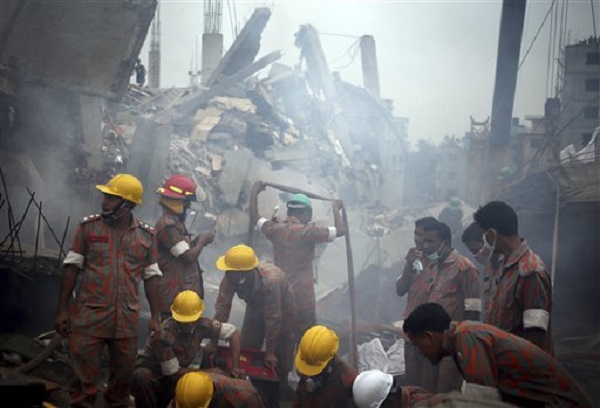Many bodies still in collapsed Bangladesh building

Workers and fire fighters are shrouded in smoke as they prepare to dislodge the debris and fallen ceiling of the garment factory building which collapsed in Savar, near Dhaka, Bangladesh on Monday, April 29, 2013. Rescue workers in Bangladesh gave up hopes of finding any more survivors in the remains of a building that collapsed five days ago, and began using heavy machinery on Monday to dislodge the rubble and look for bodies – mostly of workers in garment factories there. At least 381 people were killed when the illegally constructed, 8-story Rana Plaza collapsed in a heap on Wednesday morning along with thousands of workers in the five garment factories in the building. AP/Wong Maye-E
SAVAR, Bangladesh — Emergency workers hauling large concrete slabs from a collapsed 8-story building said Tuesday they expect to find many dead bodies when they reach the ground floor, indicating the death toll will be far more than the official 386. One estimate said it could be as high as 1,400.
Hundreds of people waited patiently at the site of the collapsed building for news of missing relatives, holding their pictures and identity cards as they watched cranes lifting sections of ceilings and floors from the rubble. Emergency workers in hard hats used drilling and cutting machines to break up the slabs into manageable pieces.
Ratna Akhtar, looking for her husband at a nearby school ground, wailed: “Give me my husband back. At least I want to see his dead body if not alive.”
The illegally constructed, 8-story Rana Plaza collapsed on the morning of April 24, bringing down the five garment factories inside. Together, they employed 3,122 workers, but it is not clear how many were on duty at the time of the tragedy. It was the deadliest disaster to hit Bangladesh’s garment industry that is worth $20 billion annually and supplies global retailers.
Roughly 2,900 people have been accounted for — about 2,500 survivors and the 386 dead. It is not clear how many people worked in other offices in the building which also housed a bank and many shops.
Article continues after this advertisementMost of the bodies have been handed to families except 49 that have been kept at the morgue of state-run Dhaka Medical College Hospital for identification. Mahmud Ali of the Bangladesh Red Crescent Society said many more bodies are believed trapped under the rubble of the building, judging by stench of decomposing flesh still emanating.
Article continues after this advertisementZillur Rahman Chowdhury, a Dhaka district administrator, put the number of missing at 100, based on the information received from the families of the missing.
But volunteers from the Social Welfare Club based at the Jahangirnagar University say the official tally is incomplete because people have little faith in the government and don’t bother reporting their loss.
Ahsan Imu, a volunteer at the club, said that based on information gathered from families at the site at least 1,000 people may be missing. However, he cautioned that there may be some duplication in the list.
On Monday, a Bangladesh court gave police 15 days to interrogate the owner of a building, Mohammed Sohel Rana. He was arrested a day earlier in a border town as he tried to flee to India. He is being questioned on charges of negligence, illegal construction and forcing workers to join work. His father, Abdul Khaleque, was also arrested on suspicion of aiding Rana to force people to work in a dangerous building.
The crimes he is accused of carry a maximum punishment of seven years. More charges could be added later.
Rana had permission to build a 5-story building but added three more floors illegally. Huge cracks appeared in the building on April 23 but Rana told tenants it was safe to go in. A bank and some first-floor shops closed after police ordered an evacuation. But managers of the garment factories on the upper floors told workers to continue their shifts.
Police have also arrested four owners of three factories.
The death toll surpassed a fire five months ago that killed 112 people and brought widespread pledges to improve worker-safety standards. But since then, very little has changed in Bangladesh.
“I think it is a wakeup call for the nation, a wakeup call for the industry and for the trade unions,” said Shirin Akter, founding president of Karmojibi Nari, a Dhaka-based Bangladeshi group that lobbies for the rights of women in the workplace.
Bangladesh’s garment industry was the third-largest in the world in 2011, after China and Italy, having grown rapidly in the past decade.
Among the garment makers in the building were Phantom Apparels, Phantom Tac, Ether Tex, New Wave Style and New Wave Bottoms. Altogether, they produced several million shirts, pants and other garments a year.
The New Wave companies, according to their website, make clothing for several major North American and European retailers.
Britain’s Primark has acknowledged it was using a factory in Rana Plaza. It said in a statement Monday that it is providing emergency aid and will pay compensation to victims who worked for its supplier.
“Primark notes the fact that its supplier shared the building with those of other retailers. We are fully aware of our responsibility. We urge these other retailers to come forward and offer assistance,” it said.
Canadian company Loblaw Inc., which also got its Joe Fresh clothing line made in Rana Plaza, said Monday it will ensure that victims and their families “receive benefits now and in the future.”
Spokeswoman Julija Hunter said the company is still working out the details, but plans to deliver support “in the best and most meaningful way possible.”
Wal-Mart said none of its clothing had been authorized to be made in the facility, but it is investigating whether there was any unauthorized production.